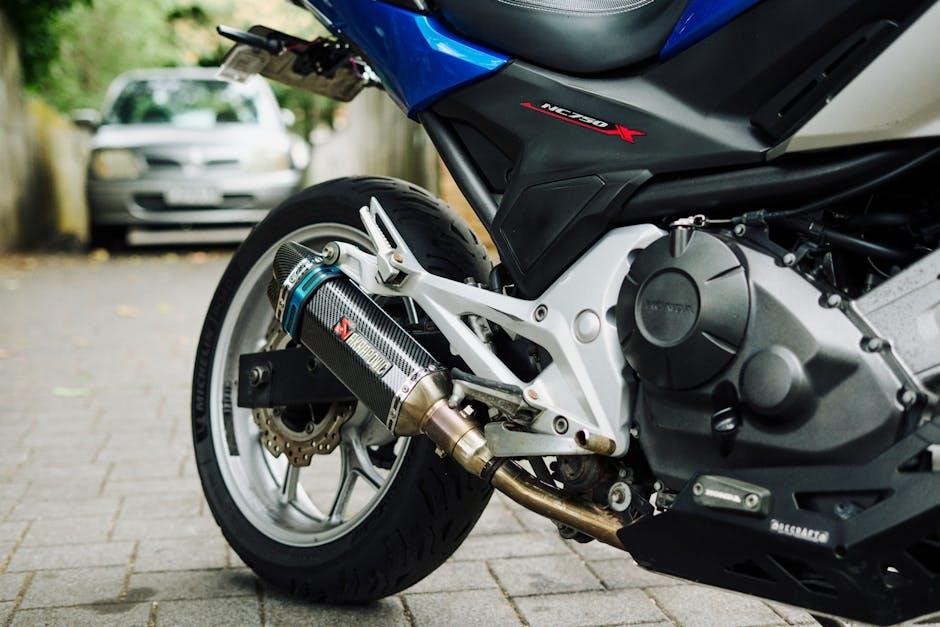
The 2021 Honda Pilot Owners Manual is a comprehensive guide designed to help you understand and operate your vehicle effectively. It covers features, maintenance, and troubleshooting, ensuring safe and optimal driving experiences.
Key Features of the 2021 Honda Pilot

The 2021 Honda Pilot is a versatile SUV that combines practicality with advanced technology. It features a powerful 3.5-liter V6 engine, offering smooth acceleration and efficient performance. The Pilot boasts a spacious interior, seating up to eight passengers, with ample cargo space for luggage or gear. The infotainment system includes an 8-inch touchscreen, Apple CarPlay, and Android Auto compatibility, ensuring seamless connectivity. Driver-assist technologies like adaptive cruise control, lane-keeping assist, and automatic emergency braking enhance safety and convenience. Additionally, the Pilot offers a multi-angle rearview camera, LED lighting, and optional all-wheel drive for improved traction in various conditions. Its exterior design includes sporty alloy wheels and a modern aesthetic, making it a stylish choice for families and adventurers alike. These features collectively make the 2021 Honda Pilot a reliable and feature-packed vehicle for everyday use.
How to Use the Owners Manual Effectively
Your 2021 Honda Pilot Owners Manual is a vital resource for understanding your vehicle’s operation, maintenance, and safety features. Start by reviewing the table of contents to locate specific sections quickly. Pay attention to the safety information and precautions, as they are critical for safe driving and vehicle longevity. Use the index to find detailed explanations of features, such as the infotainment system or driver-assist technologies. Refer to the maintenance schedule to stay on track with routine services and ensure your vehicle runs optimally. For troubleshooting, consult the dashboard warning lights section to identify and address issues promptly. Keep the manual in an accessible location, like the glove compartment, for easy reference. By familiarizing yourself with the manual, you can maximize your driving experience and extend the life of your Honda Pilot.
Downloading and Accessing the Manual
The 2021 Honda Pilot Owners Manual is readily available for download in PDF format, ensuring easy access on all devices. Visit Honda’s official website or trusted platforms like ManualsLib to find the manual; Simply select your vehicle’s model year and language to begin the download. Once downloaded, you can view the manual on your smartphone, tablet, or computer, or print it for convenience. The PDF format ensures compatibility across devices, allowing you to access critical information anytime. This manual covers essential topics, including safety features, maintenance schedules, and troubleshooting guides, making it an indispensable resource for Honda Pilot owners. Downloading the manual is free and straightforward, providing you with instant access to all the details you need to optimize your driving experience and maintain your vehicle properly.

Safety Information and Precautions
The 2021 Honda Pilot Owners Manual provides essential safety information and precautions for safe vehicle operation. Adhere to guidelines for proper use, maintenance, and understanding vehicle capabilities to prevent accidents and ensure reliability.
Important Safety Precautions for Drivers
The 2021 Honda Pilot Owners Manual emphasizes critical safety practices to ensure safe driving. Always wear a seatbelt, secure children in approved car seats, and avoid distractions like texting or using electronic devices while driving. Familiarize yourself with vehicle controls and settings before driving. Properly adjust mirrors, seats, and head restraints for optimal visibility and comfort. Never operate the vehicle under the influence of alcohol or drugs. Be mindful of adverse weather conditions and reduce speed accordingly. Keep loose items in the cabin secured to prevent injury during sudden stops or sharp turns. Regularly inspect tires, brakes, and lights to maintain vehicle safety. Follow all traffic laws and road signs. The manual also outlines proper procedures for emergencies, such as a flat tire or breakdown, to help drivers respond safely and effectively. Adhering to these precautions ensures a safer driving experience for both occupants and other road users.
Seatbelt and Airbag Information
The 2021 Honda Pilot Owners Manual highlights the importance of seatbelts and airbags for occupant safety. Always wear your seatbelt correctly, with the lap belt low across the hips and the shoulder belt snug across the chest. Ensure all passengers, including children, are properly restrained using seatbelts or appropriate child seats. The Pilot is equipped with advanced airbags, including front, side, and curtain airbags, designed to deploy in specific collision scenarios to reduce injury risk. However, airbags are supplementary to seatbelts and not a replacement. The manual also notes that airbag deployment is determined by the severity and type of impact, and they may not activate in all collisions. Proper use of seatbelts and understanding airbag functionality are crucial for maximizing safety. Additionally, the Event Data Recorder (EDR) in the Pilot records data related to airbag deployment, providing valuable information in the event of an accident.
Event Data Recorder (EDR) Overview
The 2021 Honda Pilot is equipped with an Event Data Recorder (EDR), a device that records specific data during a collision or near-collision. The EDR captures information such as vehicle speed, brake application, seatbelt usage, and airbag deployment status. This data is stored securely and can only be accessed under certain conditions, such as during vehicle repair or for legal purposes. The EDR does not record personal identifying information or vehicle location. Its purpose is to improve safety and assist in understanding how the vehicle’s systems perform in real-world scenarios. The manual emphasizes that the EDR is not a tracking device and complies with federal privacy regulations. Owners are encouraged to review the privacy policies and legal agreements outlined in the manual for further details on data usage and protection.

Understanding Your Vehicle’s Features
Understanding your vehicle’s features is essential for optimal performance, safety, and efficiency. This section guides you through the 2021 Honda Pilot’s components and technologies, ensuring a smooth driving experience.
Interior and Exterior Components
The 2021 Honda Pilot features a spacious interior with seating for up to eight passengers, offering comfort and versatility. The cabin includes premium materials, ergonomic controls, and advanced technology such as the infotainment system. Exterior components highlight a robust design with LED lighting, alloy wheels, and a practical roof rail system for added functionality. Understanding these elements ensures optimal use of your vehicle’s capabilities, enhancing both daily drives and long trips.
Infotainment and Navigation System

The 2021 Honda Pilot is equipped with an advanced infotainment system, featuring an 8-inch touchscreen display. It supports Apple CarPlay® and Android Auto™ for seamless smartphone integration, allowing you to access apps, maps, and music effortlessly. The system also includes Bluetooth® HandsFreeLink® for hands-free calling and streaming audio. Voice command functionality enables easy navigation and control of the system while driving. Additional features such as customizable settings and USB ports enhance convenience. The premium audio system delivers high-quality sound for an immersive entertainment experience. Understanding how to use these features ensures a more connected and enjoyable driving experience.

Driver-Assist and Safety Technologies
The 2021 Honda Pilot is equipped with a suite of advanced driver-assist and safety technologies designed to enhance protection and convenience. Honda Sensing® is a standard feature, offering systems like Collision Mitigation Braking, Lane Keeping Assist, and Adaptive Cruise Control. These technologies work together to help prevent accidents and reduce driver fatigue. Additionally, the Pilot features Blind Spot Information (BSI) and Rear Cross Traffic Monitoring for increased awareness while changing lanes or reversing. The Multi-Angle Rearview Camera provides a clear view of the surroundings, aiding in safe parking and maneuvering. These technologies are integrated to complement safe driving practices, ensuring a secure and confident driving experience for both drivers and passengers.

Maintenance and Service Schedule
Regular maintenance is crucial for optimal performance. Schedule oil changes, fluid checks, and tire rotations as recommended. Inspect brakes and belts periodically, and follow Honda’s guidelines for service intervals.

Recommended Maintenance Schedule
The 2021 Honda Pilot’s recommended maintenance schedule ensures your vehicle runs efficiently. Regular oil changes are suggested every 5,000 to 7,500 miles, depending on driving conditions. Tire rotations should occur every 6,000 to 8,000 miles to maintain even tread wear. Brake pads and fluid levels should be inspected annually or as indicated by the Maintenance Minder system. Timing belt replacements are recommended at 105,000 miles, while spark plugs should be replaced every 30,000 to 100,000 miles. Additionally, belts and hoses should be checked for signs of wear during routine services. Following the schedule helps prevent mechanical issues, enhances safety, and prolongs the vehicle’s lifespan. Always refer to the owner’s manual for specific intervals and guidelines tailored to your driving habits and environment.
Oil Change and Fluid Requirements
The 2021 Honda Pilot requires regular oil changes to maintain optimal performance. The recommended oil change interval is every 5,000 to 7,500 miles, depending on driving conditions. Use 0W-20 viscosity oil for best results. The oil capacity is approximately 6 quarts, including the oil filter. Always use a high-quality oil filter compatible with your vehicle to ensure proper engine lubrication. Additionally, check and top off other essential fluids, such as engine coolant, transmission fluid, and brake fluid, as outlined in the manual. Avoid using non-Honda-approved products, as they may damage your vehicle. For coolant, a 50/50 mix of Honda Long Life Coolant and distilled water is recommended. Brake fluid should be replaced every 3 years or 30,000 miles. Refer to the manual for specific instructions and intervals to keep your Pilot running smoothly and prolong its lifespan.
Tire Pressure and Rotation Guidelines
Proper tire maintenance is essential for the 2021 Honda Pilot. The recommended tire pressure is 32-40 PSI for most driving conditions, depending on the load. Check pressure monthly and before long trips using a reliable tire pressure gauge. Underinflated tires can reduce fuel efficiency and increase wear. Rotate tires every 5,000 to 8,000 miles to ensure even tread wear and extend their lifespan. Use the “rear-to-front” or “side-to-side” rotation pattern as outlined in the manual. Inspect tires for signs of uneven wear or damage during rotations. Always refer to the Tire Information placard on the driver’s doorjamb for specific pressure ratings. Proper tire care enhances safety, improves handling, and maximizes your Pilot’s performance on the road.

Troubleshooting Common Issues
The 2021 Honda Pilot manual helps identify and resolve common issues like unusual noises, reduced performance, or warning lights. Consult the manual for guidance on diagnoses and solutions.
Diagnosing Dashboard Warning Lights
DASHBOARD WARNING LIGHTS are crucial for driver awareness and vehicle safety. The 2021 Honda Pilot Owners Manual provides detailed explanations for each light, ensuring drivers understand their meanings. Common symbols include the oil can (service required), exclamation mark (brake system), and battery icon (electrical issues). If a light illuminates, consult the manual to identify the issue and recommended actions. The manual also covers the multi-information display, which offers additional diagnostic cues. For persistent or unfamiliar lights, refer to the troubleshooting section or contact a certified Honda technician. Regular checks and timely responses to warning lights help maintain vehicle health and prevent potential damage. The manual emphasizes the importance of addressing these indicators promptly to ensure safe and efficient driving. Always keep the manual handy for quick reference and guidance on resolving dashboard alerts effectively. This section is essential for all drivers to enhance their understanding and maintenance routines.
Addressing Common Mechanical Issues
THE 2021 HONDA PILOT OWNERS MANUAL provides guidance for identifying and resolving common mechanical issues. Routine maintenance, such as oil changes and fluid checks, is essential to prevent problems. The manual outlines steps to address issues like low oil levels, coolant leaks, or improper tire pressure, which can lead to engine damage or reduced performance. For example, if the oil level is low, the manual advises adding the recommended viscosity grade to avoid engine strain. Additionally, it covers troubleshooting for issues like uneven tire wear or abnormal noises. The manual emphasizes the importance of addressing these problems promptly to prevent costly repairs. By following the manual’s instructions, owners can ensure their vehicle runs smoothly and maintains its reliability. Regular inspections and adherence to maintenance schedules are key to minimizing mechanical issues and extending the life of the vehicle. This section is invaluable for proactive car care and diagnosing common concerns effectively.
Resetting the Maintenance Minder
The 2021 Honda Pilot Owners Manual details how to reset the Maintenance Minder, a system that tracks oil life and service intervals. After completing scheduled maintenance, such as an oil change, press and hold the TRIP/RESET button until the screen displays “RESET.” Then, press the INFO button to cycle to the maintenance screen and confirm the reset. This ensures the system accurately reflects the vehicle’s current condition. The manual also explains how to clear the “15%” and “5%” maintenance reminders, which appear when services are due. Properly resetting the Maintenance Minder prevents unnecessary alerts and ensures your Pilot operates efficiently. Always refer to the manual for precise instructions tailored to your vehicle’s needs. This feature helps owners stay on top of routine care, ensuring optimal performance and longevity of the vehicle. Regular resets are crucial for maintaining accurate service tracking and avoiding potential issues down the road.

Legal and Regulatory Information
The 2021 Honda Pilot Owners Manual includes essential legal and regulatory details, such as compliance with safety standards, data collection policies, and software usage agreements, ensuring adherence to federal and industry regulations.
End User License Agreement
The 2021 Honda Pilot Owners Manual includes an End User License Agreement (EULA) that governs the use of the vehicle’s software and related systems. This agreement outlines the terms and conditions under which the software may be used, including restrictions on modification, distribution, and reverse engineering. It also specifies the rights of the user and the limitations of liability for Honda. The EULA is a binding contract between the vehicle owner and Honda, ensuring compliance with intellectual property laws and software usage regulations. Owners are advised to read and understand the EULA thoroughly before using the vehicle’s advanced features. Failure to comply with the terms may result in legal consequences or limitations on system functionality. The agreement is provided in the manual to ensure transparency and legal compliance for all parties involved.
Privacy and Data Collection Policies
The 2021 Honda Pilot Owners Manual includes a detailed section on privacy and data collection policies, ensuring transparency regarding the vehicle’s data usage. The manual explains that certain features, such as navigation and driver-assist technologies, may collect data like location, driving habits, and system interactions. This information is used to enhance performance, improve safety, and provide personalized services. Honda emphasizes that user consent is required for data collection and that data is protected through secure systems. The manual also outlines how data may be shared with authorized third parties, such as service providers, for operational purposes. Owners are encouraged to review these policies to understand their rights and choices regarding data collection. Honda commits to complying with applicable privacy laws and regulations, ensuring the protection of user information. This section is essential for owners who value their privacy and want to make informed decisions about their vehicle’s data usage.
Compliance with Safety Standards
The 2021 Honda Pilot is designed to meet or exceed all applicable safety standards and regulations, as outlined in the owners manual. The vehicle complies with federal safety standards set by the National Highway Traffic Safety Administration (NHTSA) and incorporates advanced safety features to ensure occupant protection. The manual details how the Pilot meets requirements for crashworthiness, airbag systems, and other critical safety components. Additionally, Honda adheres to environmental standards, such as those related to emissions and fuel efficiency, ensuring the Pilot is both safe and eco-friendly. The manual also highlights compliance with industry standards for child safety seats and seatbelt usage, reinforcing Honda’s commitment to safety. By following these guidelines, the 2021 Honda Pilot provides a secure and reliable driving experience for all passengers.